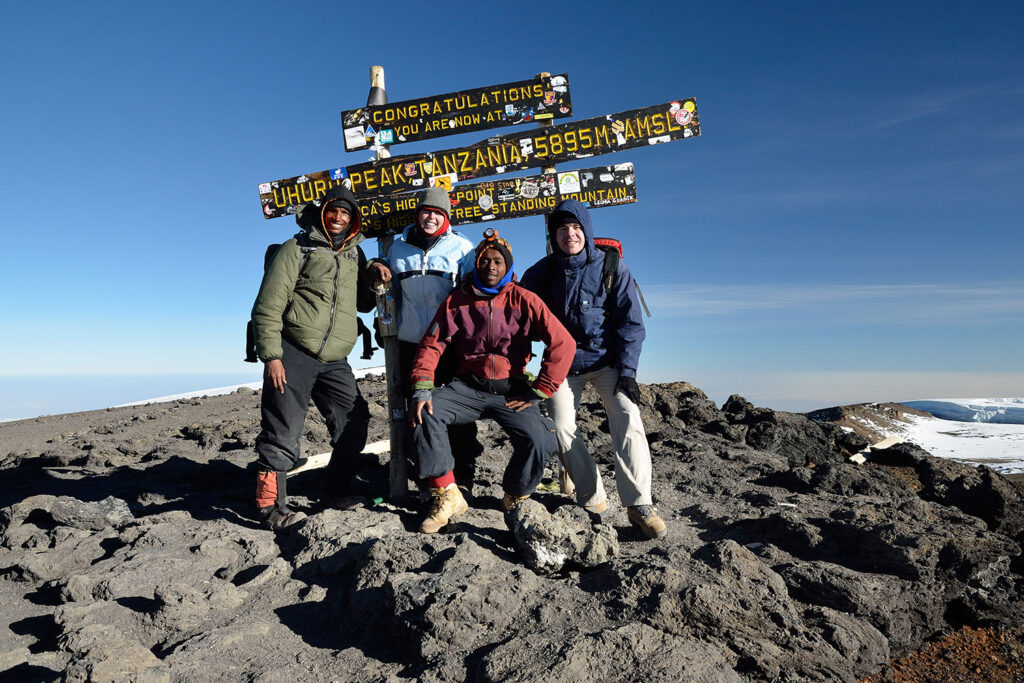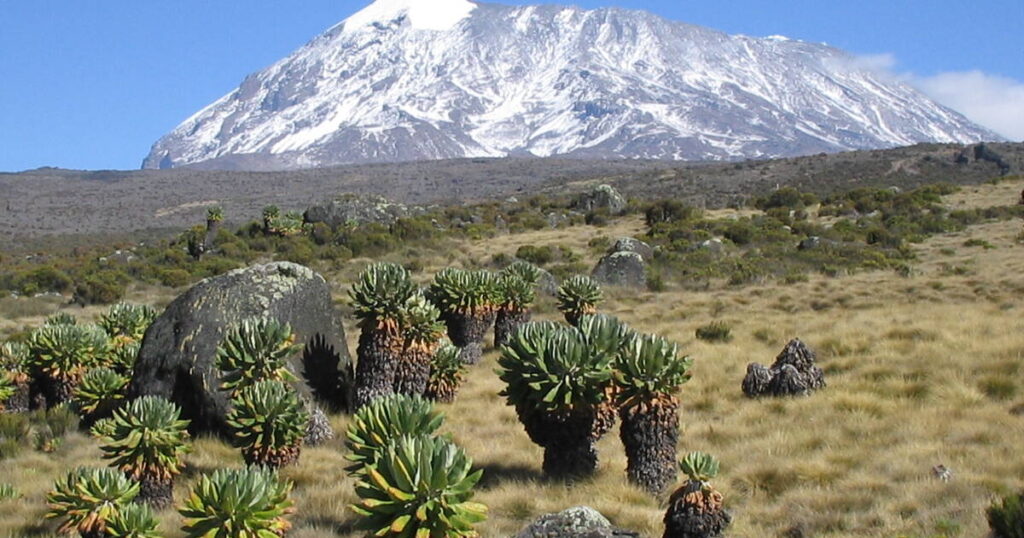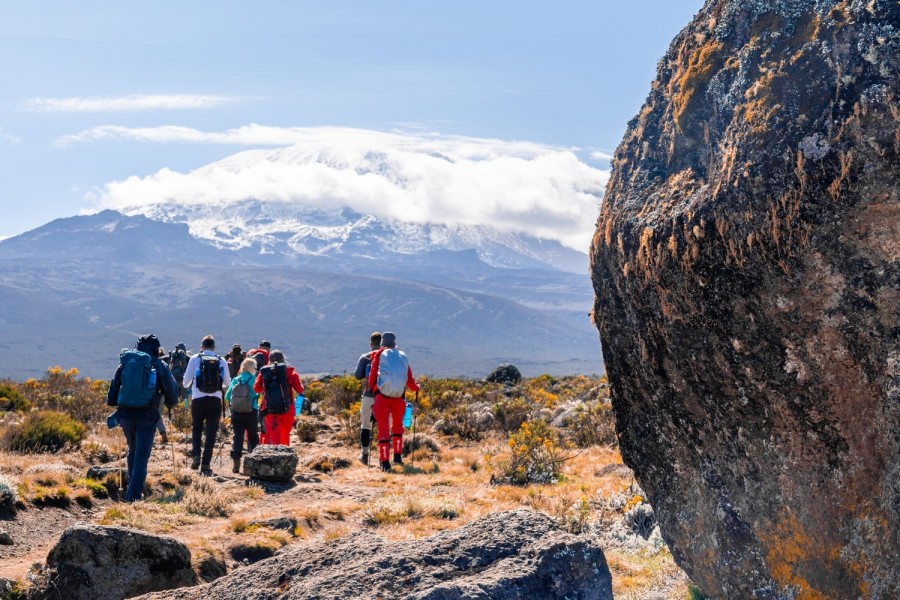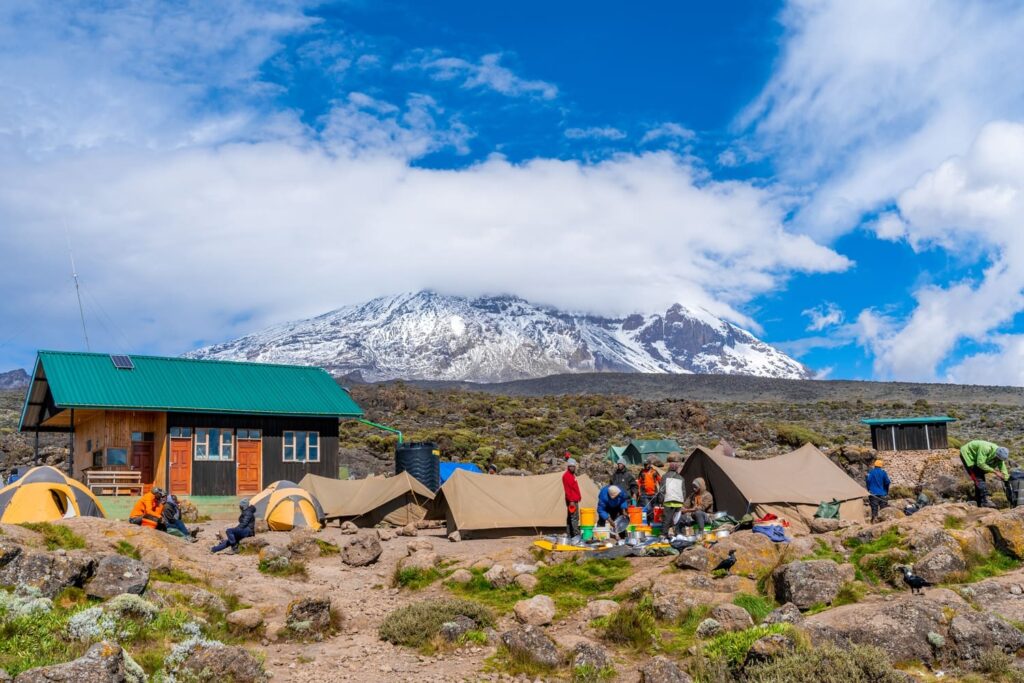Kilimanjaro National Park
Kilimanjaro National Park, Mount Kilimanjaro comprises three principal volcanic summits: Kibo, Mawenzi, and Shira. The name “Kilimanjaro” is an enigma shrouded in clouds. It may signify Mountain of Light, Mountain of Greatness, or Mountain of Caravans.
Kilimanjaro National Park was established as a game reserve in 1910, designated as a forest reserve in 1921, and officially gazetted as a national park in 1973. Kilimanjaro National Park was not allowed for public access until 1977. In 1987, UNESCO designated the park as a World Heritage Site, and in 2013, it was recognized as one of the Seven Natural Wonders of Africa. Kilimanjaro is situated in Northern Tanzania, 48 kilometers from Moshi, and has an area of 1,668 square kilometers.

Soaring over the undulating hills and plateau of northern Tanzania is the snow-capped summit of Mt. Kilimanjaro, its slopes and glaciers glistening above the ascending clouds. Kilimanjaro National Park is situated near the town of Moshi and is a designated protected area, meticulously managed to ensure climbers can experience it without leaving any evidence of their presence. The mountain ecosystems are both aesthetically stunning and remarkably diverse. The lowland slopes predominantly consist of cropland, cultivating coffee, banana, cassava, and maize for both subsistence and commercial purposes. Several major coffee plantations remain on the lower slopes, however a significant portion of the land outside the national park has been partitioned into tiny parcels. Upon entering Kilimanjaro National Park, dense lowland forest dominates the lower elevations, transitioning into alpine meadows as the height increases. At the summit, the terrain is austere and desolate, characterized primarily by rocks and ice, overlooking a stunning African vista.
Ascending Mount Kilimanjaro is the pinnacle of numerous safari trips in Tanzania. Few mountains can rival the magnificence and stunning vistas of Amboseli National Park in Kenya, the Rift Valley, and the Maasai Steppe, which are associated with Kilimanjaro. Hiking atop the ‘rooftop of Africa’—the continent’s highest elevation at 5,896 meters—constitutes a once-in-a-lifetime adventure, as it is accessible to both experienced trekkers and novices, provided they maintain an appropriate pace.
Kilimanjaro, regardless of its designation, symbolizes the captivating allure of East Africa. Upon observation, comprehension ensues. This is the highest peak in Africa and the tallest free-standing mountain globally, ascending dramatically from the adjacent coastal scrubland at approximately 900 meters to an imposing 5,895 meters (19,336 feet).

Mount Kilimanjaro is among the most accessible high peaks globally, attracting travelers from throughout the globe. The majority of climbers attain the crater rim equipped only with a walking stick, appropriate attire, and resolve. Individuals who attain Uhuru Point, the true peak, or Gillman’s Point on the crater’s rim, will have qualified for their climbing credentials.
Kilimanjaro National Park offers much more than merely mountain climbing. The climb of the slopes represents a simulated global climate journey, spanning from the tropics to the Arctic.
Prior to crossing the national park boundary (at the 2,700m contour), the farmed foothills transition into verdant montane forest, home to elusive elephants, leopards, buffalo, the endangered Abbot’s duiker, as well as many small antelope and monkeys. The moorland zone, situated at a higher elevation, features a canopy of colossal heather interspersed with extraordinary huge lobelias.
Above 4,000 meters, a bizarre alpine desert sustains minimal life, primarily consisting of resilient mosses and lichens. Ultimately, the final remnants of vegetation yield to a winter landscape adorned with ice and snow, showcasing the breathtaking splendor of the continent’s apex.
Activities in Mount Kilimanjaro National Park
Six standard walking paths to the peak plus additional, more arduous mountaineering routes. Day or overnight treks in the Shira Plateau. Nature pathways in the lower elevations. Angling for trout. Explore the picturesque Chala crater lake situated on the southeastern slopes of the mountain.
Bird Watching
Approximately 179 avian species inhabit various plant zones, providing opportunities for observation across diverse climatic regions. Species such as the White-Necked Raven, Lammergeyer, and Alpine Chat are frequently observed in high-altitude regions.
Camping:
There are 31 campsites distributed along the seven hiking trails: All camping spots are situated in wilderness areas equipped with restrooms and a park personnel residence.
Mountain climbing
Ascending Mount Kilimanjaro is not merely a climb but an expedition from the tropics to the Arctic. As altitude increases, temperatures decrease, accompanied by alterations in vegetation zones. Ascend gradually to enhance your acclimatization period and optimize your likelihood of achieving the summit. To prevent altitude sickness, provide a minimum of five nights, ideally more, for acclimatization prior to the ascent. Take your time to appreciate the majesty of the mountain.
Climbing Route in Mount Kilimanjaro
Londorosi Route:
This is a climbing path on the mountain’s western flank, consisting of five stations: Shira I, Shira II, Baranco, Karanga, and Barafu. It also provides the opportunity to utilize the Northern circuit and Western breach.
Lemosho Route:
This route, designated for ascent, is situated on the western flank of the mountain and consists of six stations at Mti Mkubwa, thereafter merging with the Londorosi route at Shira I.
Machame Route:
This is an ascending route situated in the South-Western region of the mountain, comprising five stations: Machame Hut, Shira Cave, Baranco, Karanga, and Barafu.
Umbwe route:
The path ascends on the southwestern side of the mountain and comprises four stations: the Umbwe cave within the forest belt and three further stations that converge with the Machame route at Baranco camp.
Mweka route:
This is a descending path situated on the southern slope of the mountain. It consisted of three stations: Mweka Hut, High Camp (Millennium), and Barafu. Visitors from Londorosi, Lemosho, Machame, and Umbwe utilize this route.
Kilema route:
This path is designated for cycling. It comprises three stations: Kilemamchele, Maua, and Kibo; it facilitates bidirectional traffic.
Marangu Route:
This path is designated for both ascent and descent, featuring lodges along the trail. It comprises three stations: Mandara, Horombo, and Kibo. Mountain stations are equipped with restrooms, kitchens, dining areas, and accommodations for guests. It is imperative to secure reservations in advance via a qualified mountain excursion operator.
Rongai Route:
The route ascends and offers the climber a choice of utilizing either four or five stations. Visitors who ascend via this route will descend through
Marangu route:
The first option has four stations: Simba Camp, Second Cave, Third Cave, and School Hut. The second option consists of five stations: Simba Camp, Second Cave, Kikelelwa, Mawenzi Tarn Hut, and School Hut.
How to get to Mount Kilimanjaro National Park
Accessing Mount Kilimanjaro can be achieved by traveling to Kilimanjaro International Airport, situated near the towns of Moshi and Arusha, where hiking expeditions commence. Tourists can admire views of Mount Kilimanjaro from the towns of Moshi and Arusha.
Upon arrival in Arusha, a tourist may drive to the entrance gates of Mount Kilimanjaro to commence their mountaineering expedition. The peak is at an elevation of 5,895 meters and is one of the seven summits globally.
Mount Kilimanjaro is a snow-capped mountain, and consequently, glaciers are visible during the ascent. Additionally, Mount Kilimanjaro is a stratovolcano with three volcanic cones: Shira, Kibo, and Mawenzi. Shira and Mawenzi are extinct, although Kibo is dormant and has the potential to erupt again.
Prior to selecting the optimal hiking route on the mountain, one must examine their physical condition and ability to go to the peak and return to the starting point, as many paths are steep and may require multiple days of climbing.
Various routes utilized for ascending Mount Kilimanjaro include the Lemosho route, Marangu route, Machame route, Rongai route, Umbwe route, Shira route, and the Northern route. These roads access the summit from various locations around Mount Kilimanjaro during safaris.
The most direct climbing path on Mount Kilimanjaro is the Marangu route, which requires approximately 5 to 6 days of trekking. The Marangu way is the sole path that offers hut accommodations at Kibo Hut, Mandara Hut, and Horombo Hut.
A hiking itinerary on Mount Kilimanjaro via the Marangu path commences at the Marangu gate, proceeding to Mandara hut, then to Horombo, followed by Kibo hut, ascending to Uhuru peak, returning to Horombo hut, and concluding at the Marangu gate.
Mount Kilimanjaro comprises five climatic zones encountered by trekkers on their ascent: the bushland zone, rainforest zone, moorland zone, alpine desert zone, and arctic zone.
Guides, porters, and cooks accompany hikers during their ascent of Mount Kilimanjaro. Mount Kilimanjaro is situated within Kilimanjaro National Park, which hosts several wildlife and avian species. The national park is administered by the Tanzania National Parks Authority (TANAPA).
Porters assist with luggage and equipment weighing approximately 15 to 20 kg during walks on Mount Kilimanjaro, while cooks prepare meals for the hikers on the mountain.
The duration of climbs on Mount Kilimanjaro to reach the peak and descend typically spans approximately 5 days or more, contingent upon the chosen trekking path. Tourists also visit the mountain to partake in one-day excursions without reaching the summit.
During the hike, certain paths are difficult while others are accessible to tourists with less climbing experience. Certain days during the ascent of Mount Kilimanjaro are designated for acclimatization, facilitating adaptation to altitude variations and enhancing the likelihood of reaching the summit.
Ascending to the summit of Mount Kilimanjaro, with its highest point at Uhuru Peak, may commence as early as midnight to reach the summit by morning and witness the sunrise from the peak.
Tour providers can facilitate climbing expeditions on Mount Kilimanjaro for guests. This guarantees a successful trekking experience, allowing tourists to remain unconcerned throughout their journey.
The best time to visit Mount Kilimanjaro is from June to October and furthermore from January to March. During the wet season, the number of hikers undertaking mountain excursions diminishes.
When preparing for a hike on Mount Kilimanjaro, essential criteria include procuring or renting appropriate equipment, obtaining requisite vaccinations, securing a visa, scheduling flights, and achieving physical fitness prior to the ascent.
Equipment utilized for hiking on Mount Kilimanjaro includes sleeping bags. Additional goods that hikers may include in their packing for the adventure are gloves, hiking boots, sunglasses, and sunscreen, among others.
The success rate for ascents of Mount Kilimanjaro is approximately 50%, with half of the hikers reaching the summit and returning. Factors contributing to the failure to reach the summit include altitude sickness.


